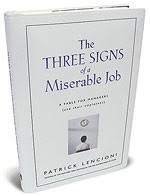A mission in the businesses that I work with is to help create “Drama-Free work environments.” Perhaps the most critical element that impacts the potential achievement of this dream is the level of positive engagement between leaders and followers.
2017 engagement data reveals the following statistics:
- 51% of the U.S. workforce is not engaged (Gallup)
- Disengaged workers cause massive losses in productivity – between $450 and $500 billion a year (Mental Health America)
- Only 16% of employees said they felt “connected and engaged” by employers (EmployeeChannel)
- It can cost 33% of an employee’s salary to replace him/her (HR Dive)
Originally titled The Three Signs of a Miserable Job, Patrick Lencioni’s The Truth About Employee Engagement gives us three simple causes that impact the level of job misery, or phrased differently, disengagement.
- Anonymity…people have a need to be known, appreciated and understood;
- Irrelevance…fulfillment occurs when the work a person does matters, and makes a difference;
- Immeasurement…if my performance isn’t measured, how can I know if I’m winning?
Leadership Challenge: as a leader, ask yourself (and for that matter, your employees!) whether any of these three causes exist in your work environment? If so, then there is a strong chance that both disengagement and drama are active participants in your current culture.
This becomes an urgent call-to-action to make improvements before you become a contributor to this alarming statistic…
- 75% of the causes of employee turnover are preventable (HR Dive)





